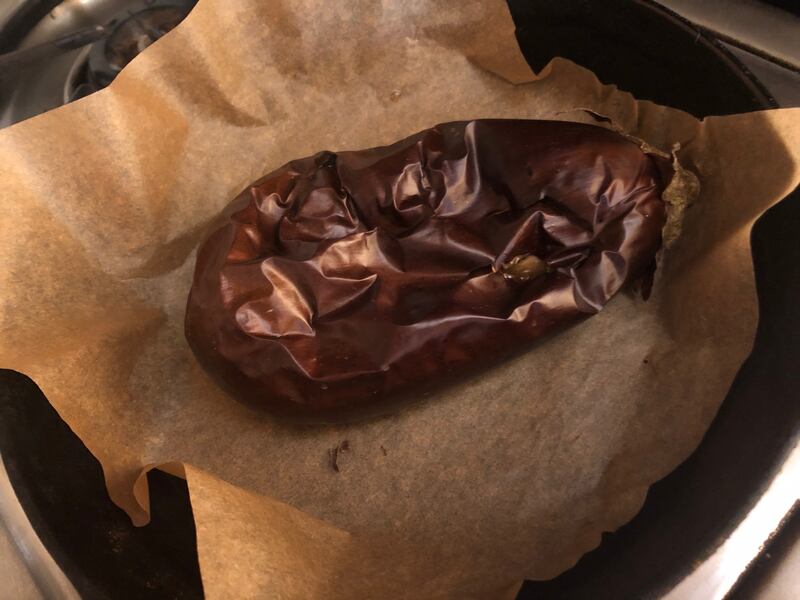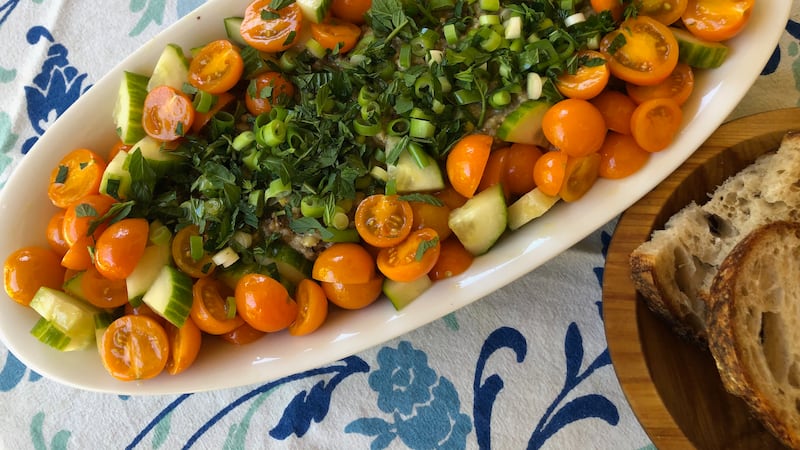Jim Dixon wrote about food for WW for more than 20 years, but these days most of his time is spent at his olive oil-focused specialty food business Wellspent Market. Jim’s always loved to eat, and he encourages his customers to cook by sending them recipes every week through his newsletter. We’re happy to have him back creating some special dishes just for WW readers.
Eggplant intimidates some cooks. They read recipes that require salting and draining to make the nightshade less bitter, a process that might’ve been helpful once but isn’t necessary with modern eggplant varieties that have had any bitter flavors bred out of them. Lazy recipe writers also repeat the shopworn caution that eggplant soaks up oil and becomes greasy. If eggplant isn’t cooked right, it can be tough and spongy.
And while there are many ways to make eggplant delicious, there’s one technique that’s nearly foolproof, incredibly easy, and adaptable to a variety of dishes: Burn it.
Cooks around the world stick whole eggplants into the fire until the skin blackens and blisters. Slightly less primitive but just as effective is cooking it on a grill using hot coals or even propane. You can get good results with a pair of tongs and a gas burner, but it sometimes gets messy when the juices boil out. The easy path to burnt eggplant is your oven.
Crank it up to 450 degrees, make a few slits in the eggplant to let steam escape, put the whole eggplant on a sheet pan or skillet, and pop it in the oven. I like to put parchment paper under it to make cleaning easier, but it’s not necessary. Let it cook for 45 minutes or longer, until the skin is dark, juices are bubbling out, and the eggplant has collapsed. Once it cools off, the skin peels away and you’ve got silky, slightly smoky, perfectly cooked eggplant.
Blend it with tahini, lemon, garlic and olive oil for the traditional spread called baba ganoush, or chop it and combine with tomatoes and cucumbers for a simple salad. I like to combine the eggplant with freekeh, Lebanese-style wheat berries that have been harvested while green and singed over open flames in the field to remove the chaff and impart a smoky flavor.

Burned Eggplant and Freekeh Salad With Miso Tahini Dressing
1 globe eggplant
1 cup freekeh*
1 pint cherry tomatoes, halved
2 6-inch Persian-style** cucumbers, split lengthwise and sliced
1/2 cup chopped flat-leaf parsley, fresh mint, or a combination of both
3 green onions, sliced thinly
1/4 cup tahini
2 tablespoons miso
Juice and zest from 1 lemon
3 cloves garlic, finely chopped
3 tablespoons extra-virgin olive oil
1 teaspoon kosher-style salt
*Freekah can be hard to find, but you can use plain wheat berries or farro (make sure it’s whole grain and not pearled, aka perlato or semi-perlato). Local farmers Anthony and Carol Boutard, suppliers of Ayers Creek cornmeal, beans, naked barley, and other heirloom crops to Portland’s best chefs and home cooks, started harvesting green wheat to make freekeh years ago. They retired early this year, but Wellspent Market acquired their stock of what they call parched green wheat and will sell it while supplies last.
**Substitute an English-style cuke; a regular slicer also works, but remove the waxy skin.
Use a knife to cut a few slits in the skin, then roast the eggplant at 450 degrees for about 45 minutes or until it collapses and the juices are bubbling out. When the eggplant is cool enough to handle, cut it in half lengthwise and pull off the peel with your hands. Use the back of a knife to scrape any cooked flesh that clings to the peel. Discard the peel and coarsely chop the eggplant. Transfer to a large bowl.
Put the freekeh in a sauce pan and add water to cook by 2-3 inches. Add salt and simmer for about 45 minutes or until tender. Drain well and add to the eggplant.
In a small bowl, combine tahini with a tablespoon or two of cold water and stir until the tahini thickens, a curious result of the hydrophilic properties of sesame seeds. Mix in the miso, olive oil, lemon juice, zest and garlic, then stir the dressing into the eggplant.
You can add the herbs and vegetables to the eggplant-freekeh mix, but for a more dramatic and Instagrammable presentation, spread the eggplant and freekah onto a plate or platter, arrange the tomatoes and cucumber around the edge, and sprinkle with herbs and green onion. Drizzle more olive oil over everything, and serve with pita or good bread.
